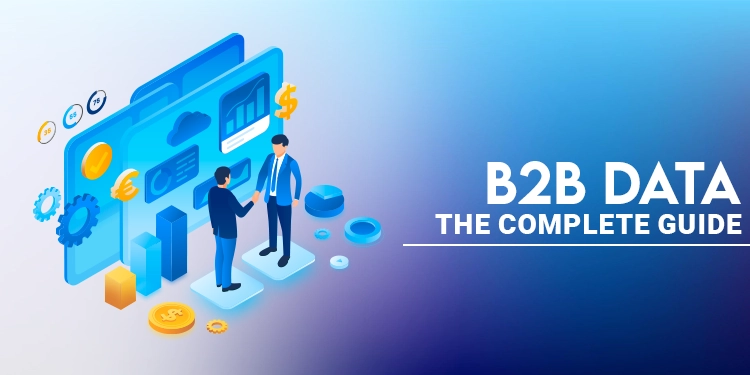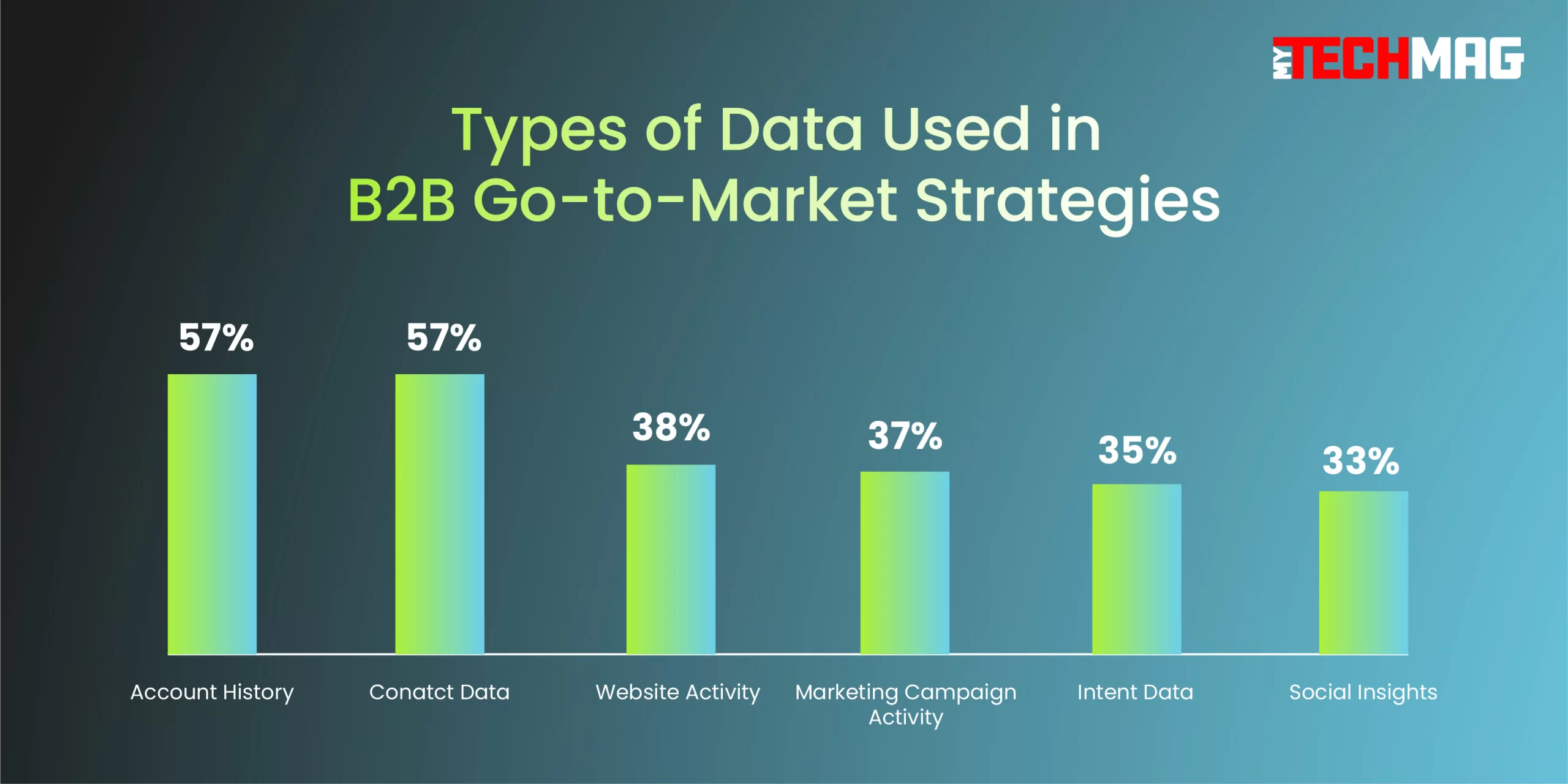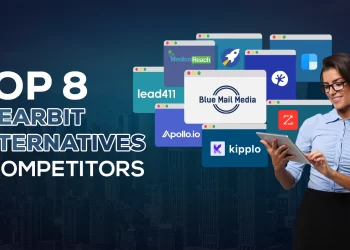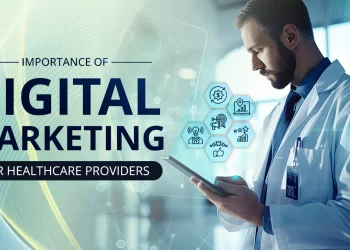Data is an integral component of the modern world. Companies with significant legible data can capitalize on it and execute targeted marketing and sales strategies to boost profits and increase revenue. Data collection paves the way for subsequent analysis and helps companies make better decisions that help them achieve their business goals.
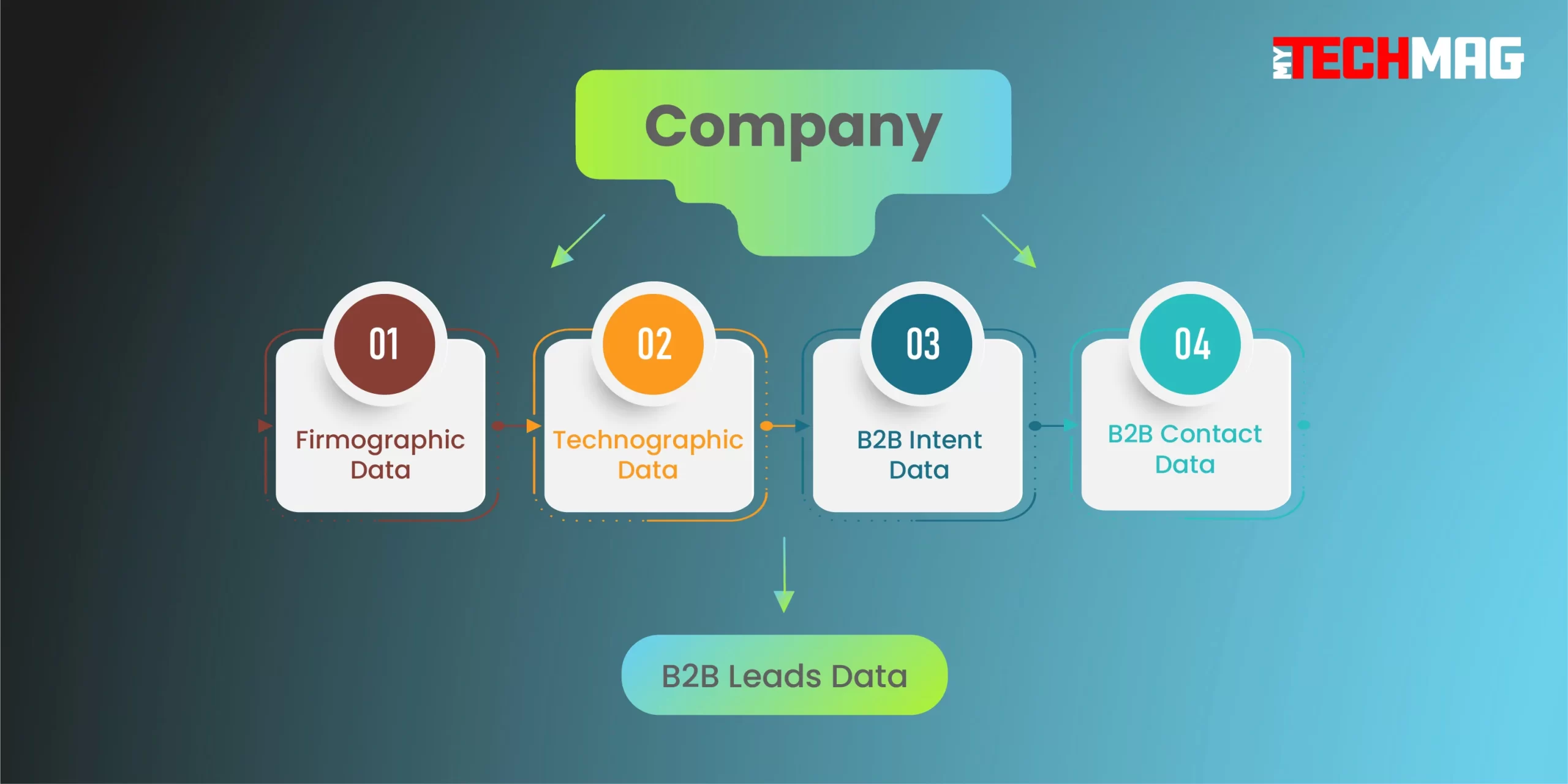
However, if you are an integral part of the B2B industry, you must be familiar with the term’ B2B data‘ used in multiple instances. But what exactly does this term mean? Does it point to something specific?
Stay with us as we present an in-depth view of B2B-targeted data and dive into the essentials of the term.
B2B Data: Examining the Roots
As the name suggests, B2B data, or business–to–business data, is an exhaustive collection of information about other businesses in the market. It provides deep insights into the specifics of different companies, like their geographical location, revenue, industry, and size of assets.
B2B data is the perfect tool to gain a comprehensive idea about leads and run personalized marketing campaigns to onboard new prospects into the funnel. It is accrued from various public and private sources, like business magazines, trade shows, seminars, conferences, and online directories.
Most information is amassed from public sources, while other data is obtained directly from the prospects.
Categories Comprised Within B2B Data
Every B2B dataset follows a standard format, comprising some essential data points. These data points aim to paint a complete picture of the target audience. The most common information contained within a B2B database includes the following:
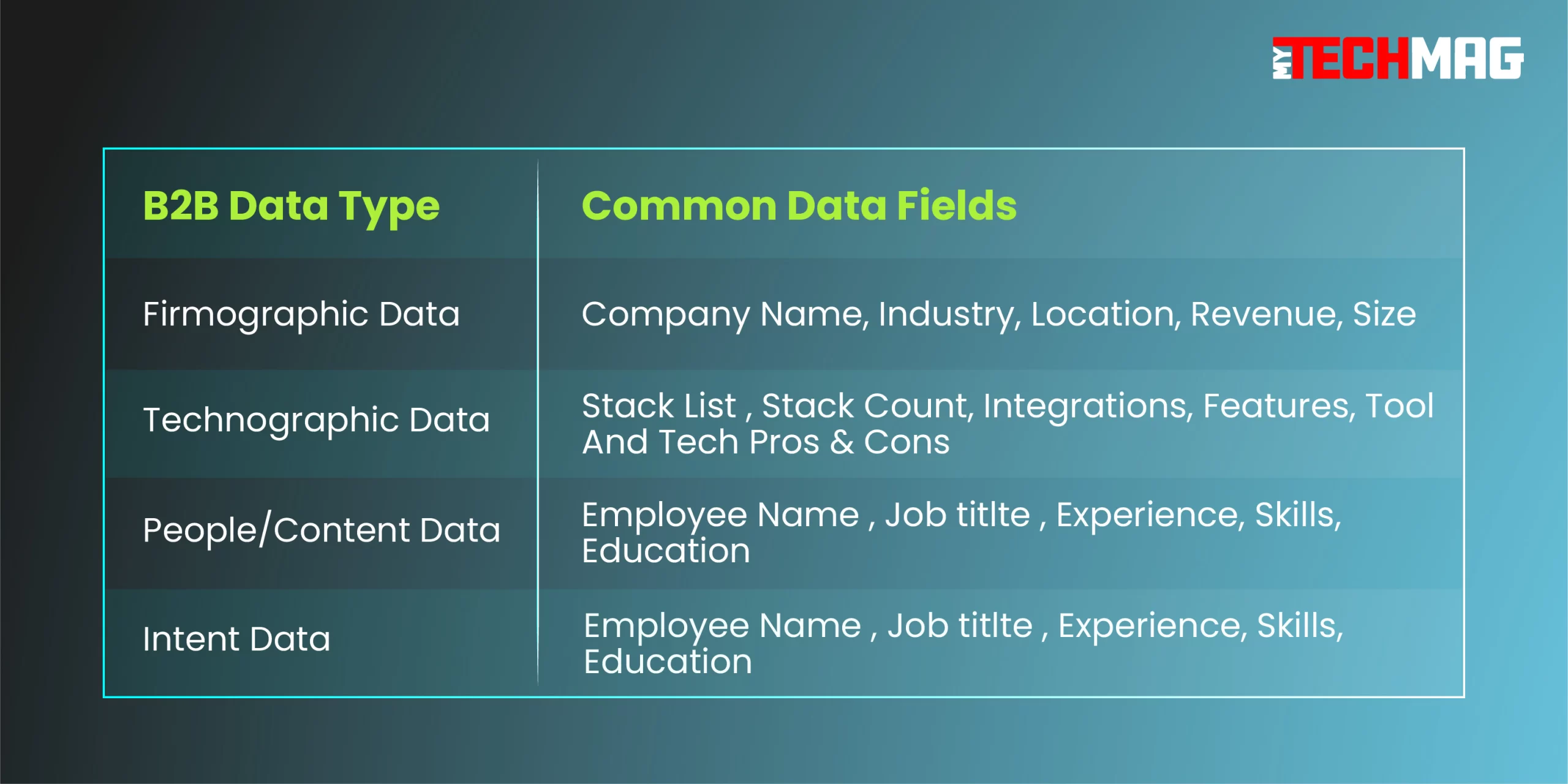
- The name of the company
- Address of the company
- Email address of the company
- SIC code
- Revenue
Additionally, it is common to find the technographic of the company and the name of the decision-makers. The ultimate goal is to break down the information into simple categories for seamless outreach efforts.
The Sources: Where is B2B Data Acquired From
B2B data collection is conducted using one of three ways –directly by the company, through an external party, or relying on a transactional deal with data vendors. The former is called internal data, while the latter is termed external third-party data. Here’s a brief overview of both:
Internal Data
The information collected directly by the business is comprised of internal data. Usually, organizations use gated content or survey forms to obtain user data and add it to their list of target audiences.
The biggest benefit of internal data is that it is obtained directly from the source. So, you can rest assured that it belongs to interested prospects keen to receive promotional messages about your offerings.
External Third-Party Data
The market is brimming with several providers possessing a database containing information about different businesses. For instance, a website dedicated to business research will contain insights like revenue, profits, employee count, and other crucial data.
Since this information is available in the public domain, companies can use it to conduct market research, identify trends and execute strategies that produce results.
Dedicated Data Vendors
The market has witnessed an influx of data vendors offering pre-packaged databases. These databases are categorized according to your targeted domain and comprise updated information about prospects in the market.
Since data experts compile these, businesses are more likely to trust them and use their services for successful outreach campaigns. Plus, with USD 15 million in losses every year due to poor data quality, businesses cannot afford to take a risk with incomplete and unreliable data.
How to Use B2B Data to Your Advantage
B2B data is created every single day. From transactions to survey forms, businesses often possess more data than they can use. Unintelligible data finds no use and needs to be converted into a readable format to complement marketing and sales strategies.
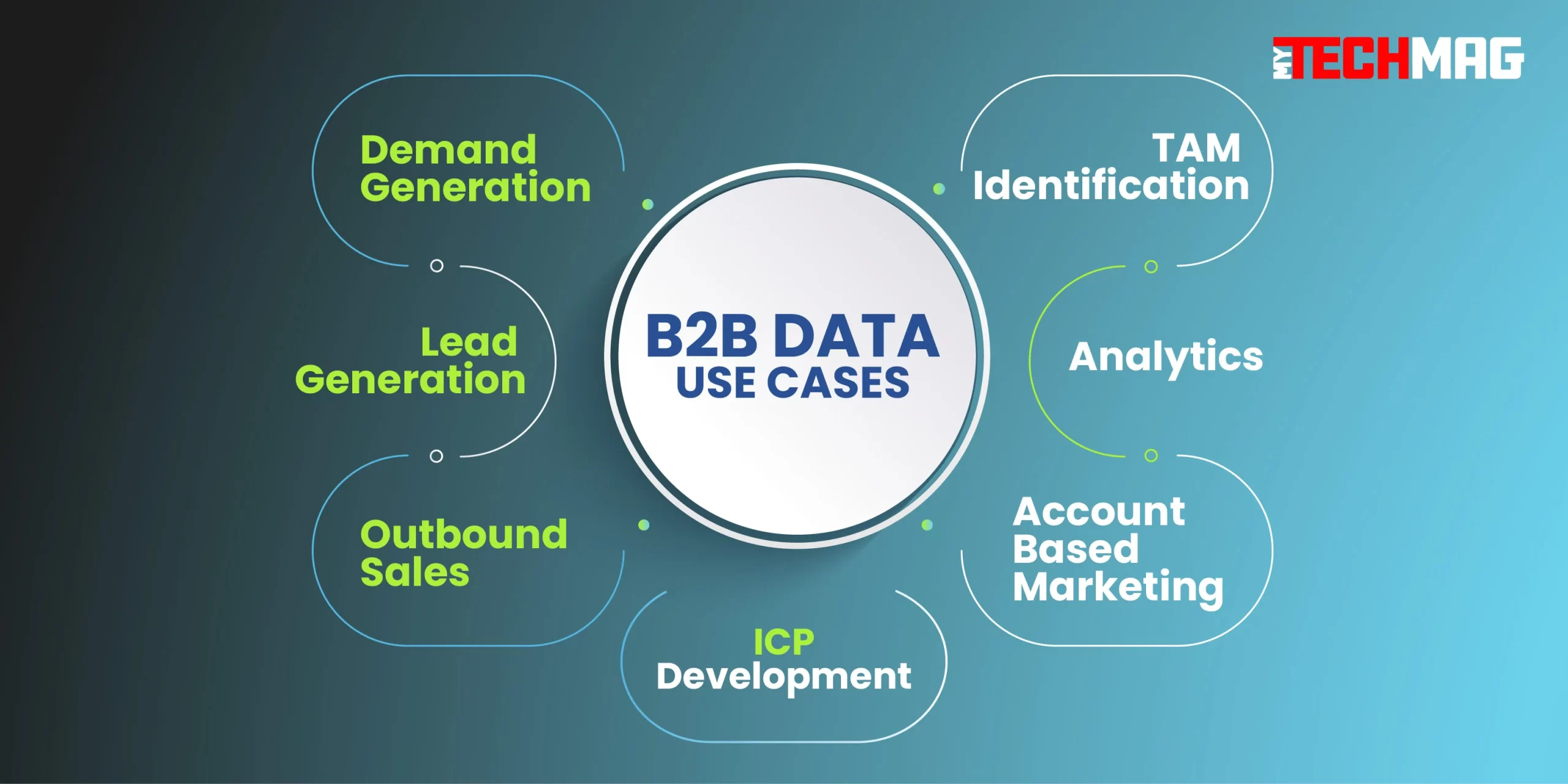
Different kinds of B2B data exist in the market, and some use cases for them are as follows:
Demand Generation
The core idea behind demand generation is to invoke a sense of curiosity for your products or services in the market. This concept emphasizes the need to reach the targeted audience and nurture an interest in your offerings. But it is impossible to generate demand without strategically using B2B data.
With a consolidated database, you can execute multiple promotional campaigns and build an omnichannel presence for your business. This will increase your company’s visibility and create familiarity among the target audience.
Lead Generation
According to HubSpot, a significant number of large and mid-size B2B companies generate a mere 5,000 qualified leads monthly. Lead generation is an extensive and time-consuming process that demands a major chunk of your marketing budget and time.
However, it is the starting point of any marketing or sales campaign. Without an updated and validated database for lead generation, your strategies are bound to underperform. Here’s where reliable B2B data comes in handy.
After defining and underlining your target audience, you can use these insights to run outreach campaigns on multiple platforms. This will have a two-pronged effect:
- Accentuate your brand awareness in the B2B space
- Help you target relevant prospects who might be interested in your offerings
Outbound Sales
As a B2B business, it is difficult to amass a loyal clientele unless you show initiative and reach out to them first. This is where the principle of outbound sales enters the picture.
It refers to the process or stage in which the sales team of a business makes contact with a prospect. Now, outbound sales techniques are not possible unless you are in possession of B2B data. It helps you contact the audience falling under your buyer persona using a variety of communication channels, including an email or phone number.
Outbound sales introduce your brand to a prospective buyer. You can then use pre-tailored sales strategies or pitches to onboard them into the sales pipeline and convince them to purchase.
Analytics
Marketing is not a linear process. It involves several variables and constantly needs to adapt according to the prospects’ sentiments. In a space like this, obtaining reliable data analytics inputs is vital to present an accurate picture of the market and power your outreach campaigns.
B2B data allows you to execute multiple campaigns and obtain insights like the click rate, open rate, and average response rates across email marketing channel and store visits, phone calls from offline campaigns. In turn, this also helps identify the preferred channel of each prospect based on the speed of responses.
Analytics are also essential in raising your company’s value proposition. By understanding the wants and preferences of prospective buyers, you can innovate and adapt your offerings to acquire a stronger hold over the B2B space.
Account-Based Marketing (ABM)
Unqualified leads are responsible for consuming extensive business resources, impacting your outreach campaigns in the long run. But what if there was a way to push unresponsive accounts out of the picture and target only high-value prospects?
Here’s where account-based marketing takes precedence. The industry trusts the essentials of ABM, as about 94% of all B2B marketers regularly use ABM.
Simply put, ABM is a way to ensure seamless collaboration between the marketing and sales teams of your organization. It is a process that explicitly targets valuable accounts and personalizes their buying experience. We are talking about tailored communication messages, targeted content, and campaigns according to their buying stage.
Special attention to these high-value accounts is a reliable strategy that pays dividends as these companies respond positively and help you achieve a promising ROI.
TAM Identification
Every business has a value proposition and specifically targeted demographics. Your products or offerings would not benefit users outside these pre-set categories. That’s why every company performs a total addressable market (TAM) identification.
Using B2B data, TAM identification helps determine the number of users in the market who will get something of value from your products or services. Essentially, it is a product of the number of users who stand to benefit from your offerings and the price they are ready to pay for the product or service.
TAM is an initial part of market research, as it does not consider competition or the limitations of your business. The only focus is if the products or services command a significant market that will yield profits.
ICP Development
Ideal customer profile, or ICP, is an estimated metric of your targeted customers. It is a crucial process in B2B marketing that defines the perfect client for your business.
For example, if you are a company that manufactures medical devices, your ideal customer profile would entail hospitals and other healthcare institutions with the necessary facilities.
The primary aim of drafting an ICP is to enable more targeted marketing and sales efforts. You will be more focused on marketing your offerings to businesses that genuinely need them. Focused sales efforts would also help you save marketing resources and get a better ROI in the long run.
What Benefits Does B2B Data Offer?
In-depth insights into your target audience are a core feature of B2B data. It helps acquire a more comprehensive view of the market and enables impactful strategies that bring more prospective buyers into the mix.
Plus, B2B data offers varying benefits for different teams. Here is a brief overview of how it helps teams function.
For Marketing Teams
- Enable data-driven decisions to drive more impactful campaigns
- Helps tap into new markets by providing a complete assessment of the target audience
- Recognize and target high-value accounts for successful account-based marketing
- Eases the formation of buyer personas for better targetability
For Sales Teams
- Personalized sales pitches that appeal to the prospects’ pain points
- Better insights into product sentiments to alter sales strategies
- Improved reach and the freedom to contact qualified leads
- Access to relevant insights to enhance outbound sales techniques
For Revenue Operations Teams
- Helps determine the accurate TAM for better allotment and calculation of funds
- Enables alignment of marketing and sales teams for higher conversion rates
- Existing data assists them in formulating a structural plan for increasing revenue
Different Types of B2B Data
B2B data does not exist as a general entity. Companies can leverage several types of B2B data according to their needs and marketing channels. Some of the most widespread types are as follows:
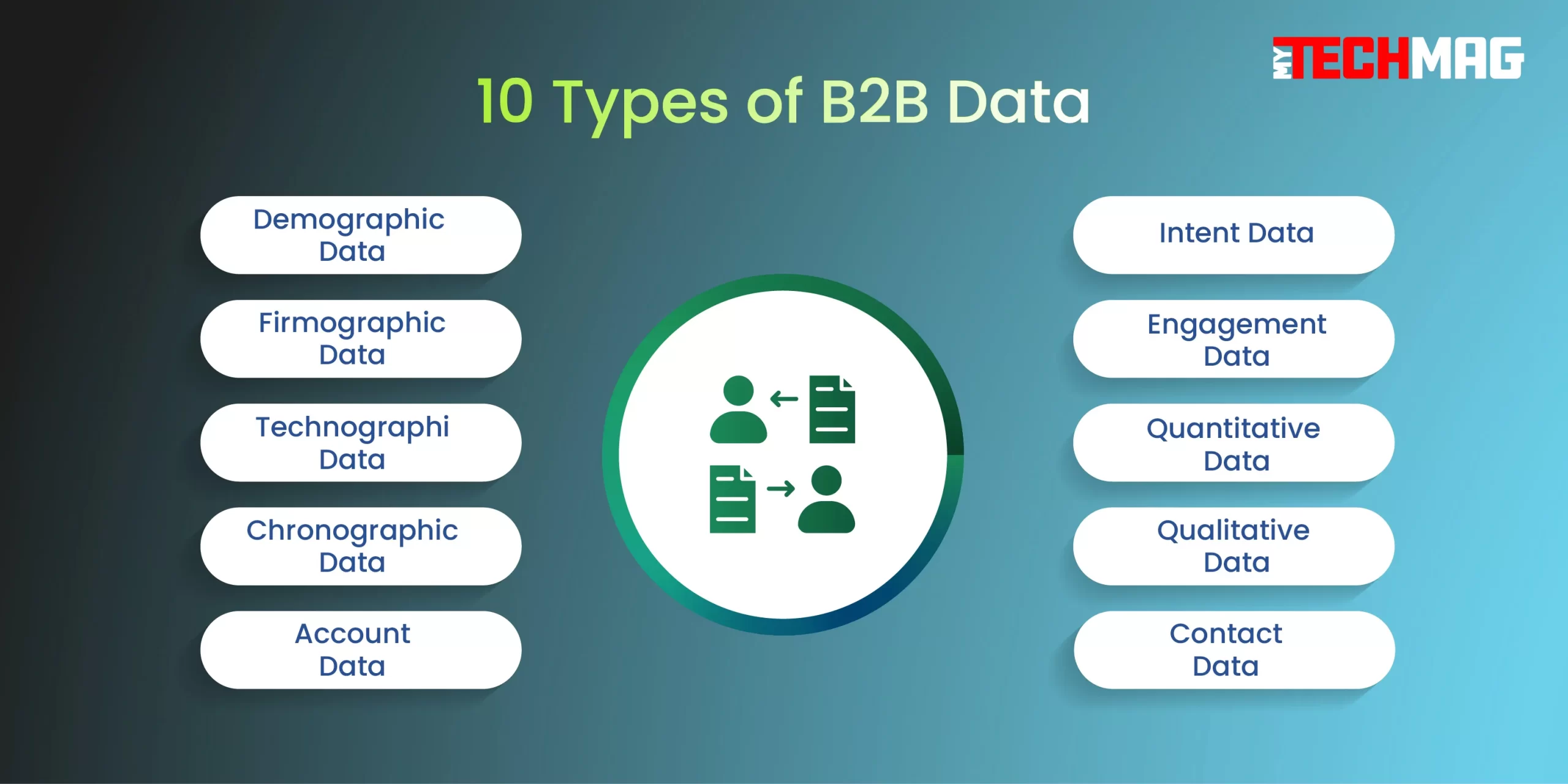
Demographic Data
As the name suggests, demographic data provides you with information about the various attributes of your target audience—for instance, the prospect’s age, gender, and address fall under demographics. At times, demographic data also include their occupation and income for better categorization. It helps you divide your audience into easily identifiable groups and execute marketing strategies according to their pain points.
Firmographic Data
Just as demographics focus on an individual, firmographics is more concerned with the specifics of an organization. It comprises data points like the type of business, total clients, geographical location of the company, and technologies used to present a complete picture of the business.
Technographic Data
As the world moves into digitalization, companies are compelled to onboard different technologies to ease operations and stay on par with competitors. With the technographic data of an organization, you can understand the current technological integrations in the organization.
If you are an IT solution-providing company, you can use this information to suggest new technological tools for the business.
Chronographic Data
Chronographic data focuses on the different events that occur within the organization. For instance, a new employee joining the company falls under the umbrella of chronological data. At the same time, a business moving from one location is also a crucial point in chronographic data.
Intent Data
Intent data is a measure of the audience’s willingness to purchase your products or services. It provides a look into the audience’s thought process by analyzing their online behaviors. Based on the intent data, you can practice targeted marketing and personalize your promotions to entice prospective buyers.
Account Data
Account-level data focuses on a broader picture and provides insights into the events or changes occurring within an account. Since more than one user can operate an account, it is a reliable metric to track any considerable changes in the organization.
Contact Data
Perhaps the simplest in terms of collection, contact data refers to the identifying details of the employees of different companies. It includes their full names, email addresses, job titles, and phone numbers to enable targeted outreach campaigns.
Engagement Data
Sometimes, you might want to check the overall performance and sentiments associated with a business. This can be best done by analyzing their interaction with customers on different marketing channels.
Engagement data delivers an idea of the company’s stand in the market, helping you devise a more targeted sales pitch to address their problems.
Quantitative Data
Data-driven decisions are gaining momentum, with Gartner estimating that 65% of organizations will move from intuitive to data-powered decisions by 2026. Hence, quantitative data is a vital metric that helps you understand the numbers of each business and market your products or services as solutions to their dilemmas.
Qualitative Data
Qualitative data is obtained directly from the source, i.e., from the prospects. It gives you an idea about the sentiments of the users and an insight into their behavioral patterns. Basically, you obtain a picture of the expectations and complaints of potential buyers, helping you improve your offerings and fill the niche in the market.
The Process of Collecting B2B Data
B2B data is available from a variety of sources. If you lack an internal method of collecting data, you can use public or private sources to amass a database and execute lead generation campaigns. Here’s how each of these sources operates:
Public Sources
Usually, a treasure trove of information is out in the public domain. With mediums like business magazines, trade show directories, websites, and conference lists, you can collect raw data and convert it into a legible form. Collecting data from public sources also means that you are free from the provisions of data privacy laws like GDPR or CCPA.
Private Sources
Data vendors offer a pre-made database that can be customized according to the target audience. However, these companies have a transactional approach to their databases. Private sources include financial and market intelligence companies with dedicated in-house teams to collect and organize the data.
How to Recognise High-Quality Data?
Every database is not created equal. This means you cannot trust all the data you accrue from public sources. It is necessary to follow some tips and tricks to identify which data points are worth using and which can be discarded.
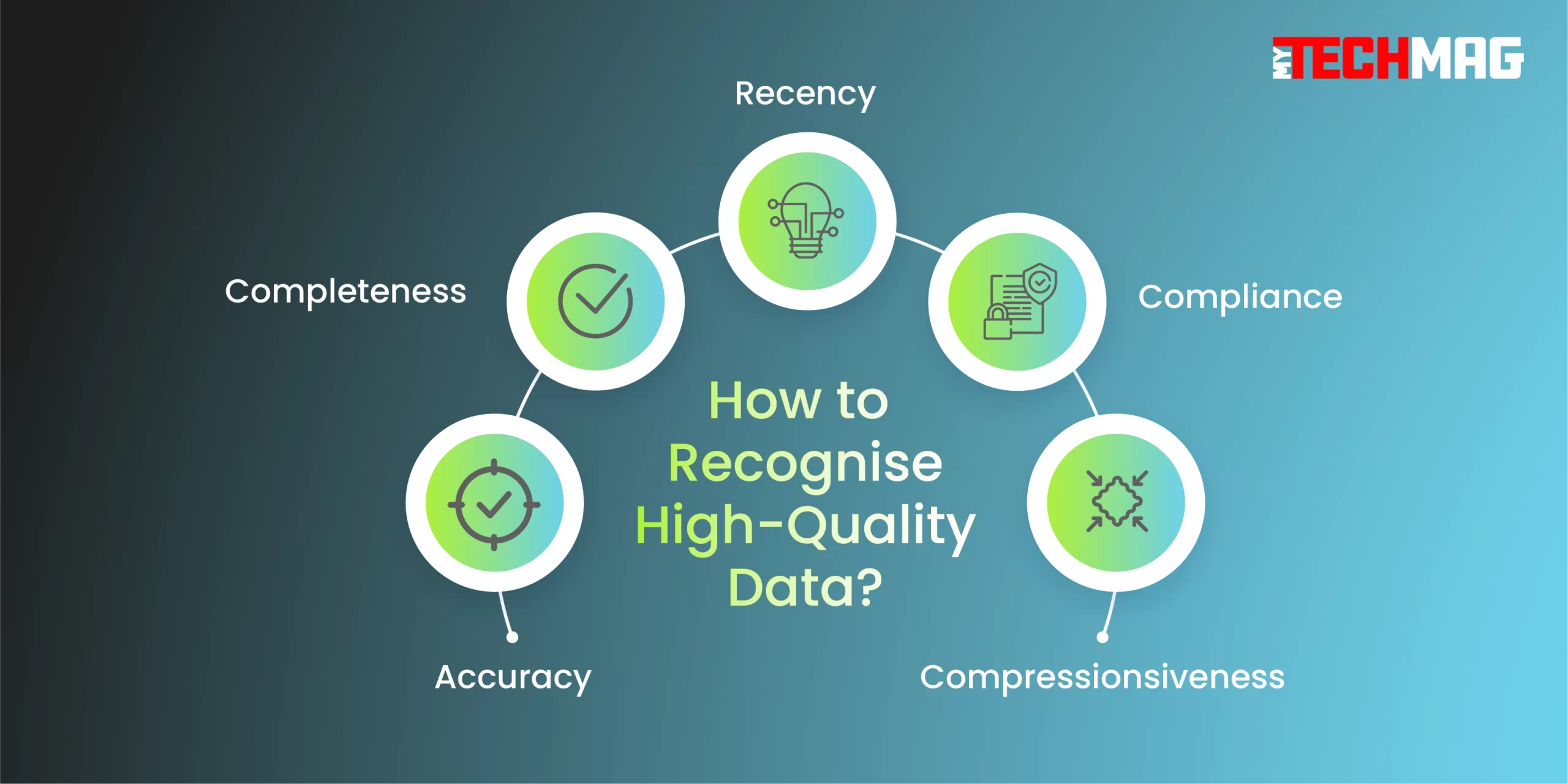
Here are some methods to check the quality of your data:
- Bounce rates: Experiment with your database and review for the response in the market. If you witness significant bounce rates within a short period, your data is loaded with inaccuracies.
- Time-to-value: In simple words, it is the time it takes for the data to be valuable for your organization. Is it causing higher response rates? Are your campaigns reaching the right audience?
- Empty values: Missing pieces of information form the basis for unsuccessful outreach efforts. Analyze your data to check if it possesses incomplete fields or other inaccuracies.
Tips to Maintain High-Quality Data
Naturally, data can never remain the same. Information about users and the company constantly changes, so the database needs to be altered to fit the requirements. Here are some ways to prepare your database against being redundant:
Data Cleansing
You must subject your database to a thorough data cleansing process every few months. It is the process of removing outdated and irrelevant information from your records to maintain their accuracy and filter redundant data.
Data Enrichment
Internal and external data can be used to prepare a highly accurate database that powers up marketing and sales strategies. Data enrichment is a process where you can combine opt-in data acquired from internal sources with third-party external information to cross-check and verify the accuracy of each data point.
Data Appending
You might notice that sometimes, your internal data has plenty of missing fields. Any campaign executed using this incomplete data can prove disastrous. Data appending is a process where you use external data to fill in these gaps and gain possession of a complete database.
Data Validation
Think of it as a way to refresh your data. With data validation, you can verify the contacts on the list, eliminate duplicate information and remove invalid emails to remain in possession of a validated database with high-quality data points.
The Trends & Tools Influencing B2B Data
B2B data is at a crucial stage, where it is employed by all organizations in the market. Without B2B data, it is challenging to identify prospective buyers and market to them using personalized tactics.
But all this while, several trends have impacted B2B data. Here are the most influential trends in 2023:
- The emergence of AI: Artificial intelligence integrations have changed the landscape, with machine learning systems making acquiring user and company information easier. Plus, it is easier to identify patterns in existing data due to the superior analyzing capabilities of AI systems.
- Stringent data privacy laws: With the rise of CCPA and GDPR, data privacy is at its strongest. B2B marketers must consider these regulations before adopting a data collection strategy.
Final Thoughts
Undoubtedly, B2B data is crucial in the long term. It is bound to ease customization, enable tailored campaigns, and improve the ROI for organizations. The only pre-requisite is to be aware of the trends influencing this space and capitalizing on them for maximum profits.
In fact, the current technological landscape has now made using B2B data an absolute necessity. This data is now used to formulate and fuel various core strategies and business processes.
As a result, organizations are now equipped with enhanced lead generation quality, better market research, better businesses opportunities, offer better customer service, take better business decisions, and so on! As the workforce becomes more digital, firms will turn to B2B data to establish relationships with other businesses and maintain their ROI.
With adept analytics and data management systems in place, leverage B2B data to its total capacity, and watch your marketing efforts flourish!
Gracie Johnson is a Senior Content Writer at MyTechMag. She is an enthusiastic learner and loves to explore all the areas of technology.


